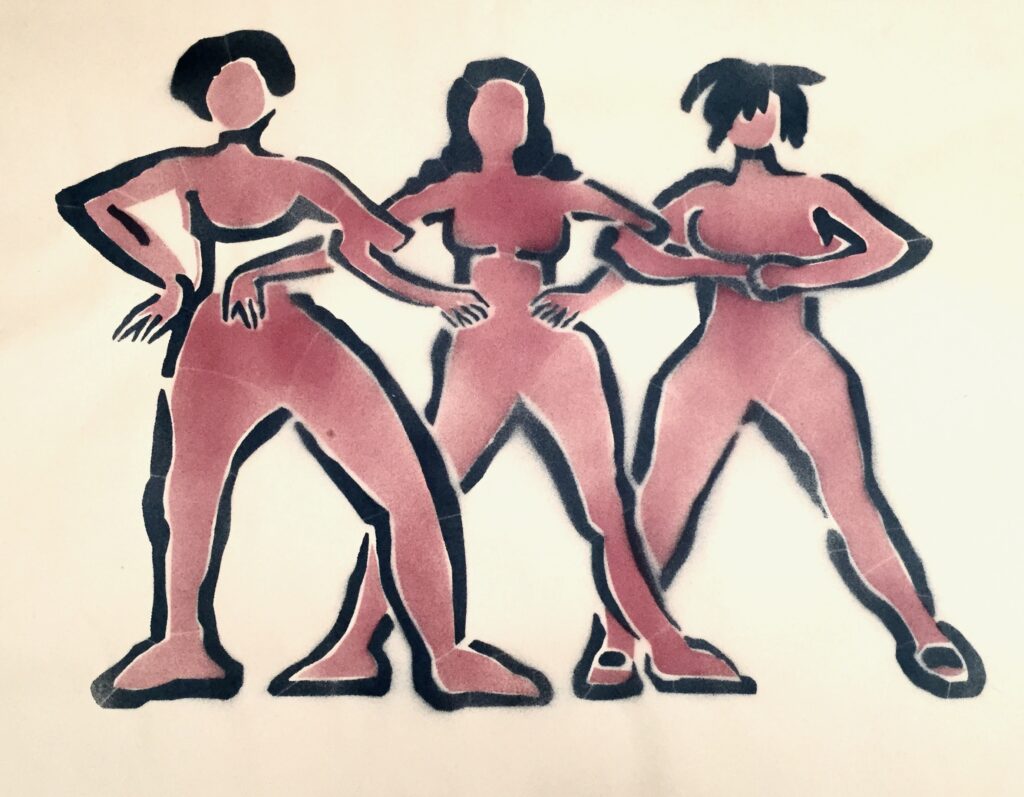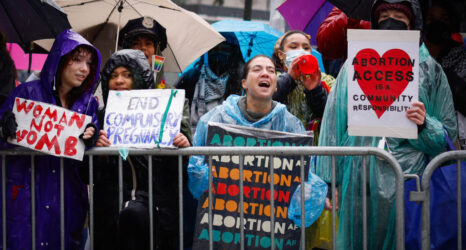A key insight of abortion self-help: For people to practice body sovereignty, they first have to learn how to be in their bodies.

Since the 2022 Supreme Court decision to overturn the 50-year-old constitutional right to abortion, the Christian right and its powerful anti-abortion, anti-trans lobby have escalated attacks on the health of women and trans people. Currently, they are targeting the FDA-approved abortion pill mifepristone, and in the coming months, the Supreme Court will hear a challenge brought by the right that it could use to restrict the pill significantly.
The right is also leading the charge on strict state-level abortion bans and expanding its assault to restrict birth control and no-fault divorce.
What can we do to turn the tide?
My book Deep Care: The Radical Activists Who Provided Abortions, Defied the Law, and Fought to Keep Clinics Open chronicles four decades of creative grassroots resistance to the anti-abortion movement, offering invaluable lessons for today. The book is about abortion defense:
- how laypeople worked underground in “self-help” groups to learn how to perform abortions using manual vacuum aspiration technology;
- how they founded licensed feminist women’s health centers, such as Oakland Women’s Choice Clinic, and provided full-spectrum care; and
- how, with the rise of anti-abortion blockades in the 1980s, they developed clinic defense tactics to keep clinics open and help people access services.
The abortion movement history I illuminate in Deep Care contains within it a history of feminist sex research and education, which the following excerpt exemplifies. Many abortion defenders were also sexual health educators who promoted sexual pleasure and sex positivity. They understood that the right’s effort to repress desire, police sexuality, and mandate reproduction was a strategy for social control.
One self-helper, whose pseudonym is Max, described the relationship between her abortion and sex education work in this way:
“Self-help intersected with my sex education work, which was the positive side of what we were fighting for—being embodied, sexually happy people.”
As abortion defenders have long understood, the antidote to sexual repression is sexual liberation, and innovative community-based feminist sex education is an essential tool for understanding and enjoying our bodies.
Excerpt adapted from Deep Care: The Radical Activists Who Provided Abortions, Defied the Law and Fought to Keep Clinics Open, available now.
Gynecological and abortion self-helpers were community scientists who developed innovative approaches to teaching and research. They worked with their hands, masturbating to orgasm to understand the anatomy of their pleasure and examining the consistency of their cervical mucus to track their fertility. They worked with graphite on paper, detailing female sex organs from new angles and with greater precision than anyone ever had before. They worked with microscopes, analyzing cultures they had grown themselves and counting sperm.
Self-helpers’ community-science projects undermined conventional top-down research methods and instead centered nonhierarchical, participatory, hands-on approaches. In the process, they charted new objectives for community science, contributed knowledge to anatomy and sexuality studies as well as to the study of HIV/AIDS, and asked philosophical questions about what research could be and do.
“We didn’t start out as researchers,” said longtime Women’s Choice director Linci Comy. “But the status quo of the medical industry was denying women’s sexuality, down to the microscopic level. We were individuals who needed questions answered. The answers had been denied to us by the world.”
They understood that having an accurate and precise language for anatomy is a precondition for changing scientific and social narratives about how people orgasm and, ultimately, for liberating them sexually.
Abortion self-help asked many different research questions, and one of them led a Los Angeles group of self-helpers to perform a breakthrough study of the clitoris for a book the Federation of Feminist Women’s Health Centers was working on. In the process, they honed a research method that emphasized sustained researcher participation.
In 1981, the Federation published A New View of a Woman’s Body: A Fully Illustrated Guide. The book contains chapters on birth control, menstrual extraction, abortion, and health problems of women and, importantly, chronicles the methods and findings of self-helpers.
In a chapter titled “The Clitoris: A Feminist Perspective,” the authors assert, “Using self-examination, personal observation and meticulous analysis, we arrived at a new view of the clitoris.” They argue in New View that the clitoris is a “whole complex organ” with tissue, muscles, nerves and blood vessels that go beyond the external glans, hood and shaft often talked about as the extent of it.
Self-helpers named their method: a synthesis of self-examination, personal observation and analysis.
“We … observed the changes that occur during the sexual-response cycle when some of the study participants masturbated to orgasm. Then we compared our life experiences to the textbook version,” they wrote.
In this way, their method emphasizes researcher participation. Through it, the authors produced detailed descriptions and analysis of the relationship between the anatomy of the clitoris and the stages of orgasm. The chapter also includes original anatomical illustrations by a self-helper named Suzann Gage that depict the clitoris—both external and internal views from various angles—as having greater reach and complexity than previously thought. The authors explain that the illustrations are based on “painstaking comparisons” of existing research to their own personal observations. These methods are an implicit critique of the idea of scientific objectivity. Instead, they advocate, or require, trusting one’s own experience.
There is no medical community that has taken ownership in the research, in the management, in the diagnosis of vulva-related conditions.
Rachel Rubin
The chapter on the clitoris models a gradual, hands-on process of producing and transmitting knowledge. Tissue, muscles, nerves, blood vessels, glands, skin and more that make up the clitoris are described and analyzed in detail. Upon finding that not all parts were named in the existing medical literature, self-helpers named those parts themselves: “Another spongy body extends inward along the ceiling of the vagina. This pad of soft tissue can be easily located by inserting your finger into the vagina and pressing forward toward the pubic bone; it surrounds the urethra, undoubtedly protecting it from direct pressure during sexual activity. This structure was not named in the textbooks so we called it the ‘urethral sponge.’”
They also identified and named the “perineal sponge,” erectile tissue between the vagina and anus.
“This redefinition of the clitoris is no mere semantic quibble,” the authors argued.
They understood that having an accurate and precise language for anatomy is a precondition for changing scientific and social narratives about how people orgasm and, ultimately, for liberating them sexually.
A better framework is also essential for understanding the consequences of medical procedures such as episiotomy, the cut that is sometimes made to the posterior vaginal wall, or the skin between the vagina and the anus, during birth: “When it is realized … that if the perineum is part of our sex organ, an episiotomy is more than a surgical incision. It becomes a mutilation of the clitoris.”
The community scientists who wrote New View drive home a key insight of abortion self-help: that for people to practice body sovereignty, they first have to learn how to be in their bodies and how to think and act self-consciously from that material place of the body.
In 2022, sexual health specialist Rachel Rubin told science writer Rachel Gross for the New York Times, “[The clitoris is] completely ignored by pretty much everyone. … There is no medical community that has taken ownership in the research, in the management, in the diagnosis of vulva-related conditions.”
It is astonishing that this could still be true 40 years after the publication of New View. But to be clear, a medical community did take initial ownership in and lay the groundwork for future research—that movement was abortion self-help.
Up next:
U.S. democracy is at a dangerous inflection point—from the demise of abortion rights, to a lack of pay equity and parental leave, to skyrocketing maternal mortality, and attacks on trans health. Left unchecked, these crises will lead to wider gaps in political participation and representation. For 50 years, Ms. has been forging feminist journalism—reporting, rebelling and truth-telling from the front-lines, championing the Equal Rights Amendment, and centering the stories of those most impacted. With all that’s at stake for equality, we are redoubling our commitment for the next 50 years. In turn, we need your help, Support Ms. today with a donation—any amount that is meaningful to you. For as little as $5 each month, you’ll receive the print magazine along with our e-newsletters, action alerts, and invitations to Ms. Studios events and podcasts. We are grateful for your loyalty and ferocity.





